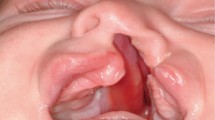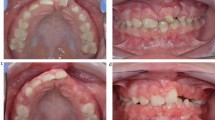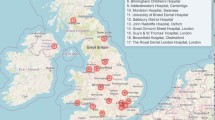Abstract
This paper describes the impact of cleft lip and palate on speech. It provides an overview for the dental clinician of the key issues affecting speech development and clarity. The paper summarises the complex speech mechanism and cleft-related factors that affect speech, including palatal, dental and occlusal anomalies. It outlines the framework for speech assessment throughout the cleft pathway and provides a description of cleft speech disorder, as well as describing treatment approaches for cleft speech and velopharyngeal dysfunction.
This is followed by a spotlight on speech prosthetics for treating nasal speech, with an emphasis on joint management by the Speech and Language Therapist and Consultant in Restorative Dentistry. This includes the core multidisciplinary approach, clinician and patient-reported outcome measures, and brief discussion of national developments in this area.
The importance of multidisciplinary cleft care is highlighted and, within this, the essential interaction between speech and dental clinicians in providing routine care, as well as in delivering a highly specialist speech prosthetics service.
Key points
-
An overview of the impact of cleft lip and palate on speech.
-
Speech is a core life skill: palatal, dental, and occlusal anomalies associated with cleft can affect speech clarity at any age.
-
Speech prosthetics is an appropriate treatment option for velopharyngeal dysfunction in selected patients and should be delivered by a specialist multidisciplinary team.
This is a preview of subscription content, access via your institution
Access options
Subscribe to this journal
Receive 24 print issues and online access
$259.00 per year
only $10.79 per issue
Buy this article
- Purchase on Springer Link
- Instant access to full article PDF
Prices may be subject to local taxes which are calculated during checkout







Similar content being viewed by others
References
Ness A R, Wills A K, Waylen A et al. Centralization of cleft care in the UK. Part 6: a tale of two studies. Orthod Craniofac Res 2015; 18: 56-62.
Colbert S D, Green B, Brennan P A, Mercer N. Contemporary management of cleft lip and palate in the United Kingdom. Have we reached the turning point? Br J Oral Maxillofac Surg 2015; 53: 594-859.
Hyde A C, Moriarty L, Morgan A G, Elsharkasi L M, Deery C. Speech and the dental interface. Dent Update 2018; 45: 795-803.
Britton L, Albery L, Bowden M, Harding-Bell A, Phippen G, Sell D. A cross-sectional cohort study of speech in five-year-olds with cleft palate ± lip to support development of national audit standards: benchmarking speech standards in the United Kingdom. Cleft Palate Craniofac J 2014; 51: 431-451.
Lane H, Harding S, Wren Y. A systematic review of early speech interventions for children with cleft palate. Int J Lang Commun Disord 2022; 57: 226-245.
Larsson A, Miniscalco C, Mark H, Jönsson R, Persson C. Persisting speech difficulties at 7-8 years of age - a longitudinal study of speech production in internationally adopted children with cleft lip and palate. Logoped Phoniatr Vocol 2022; DOI: 10.1080/14015439.2022.2083673.
Nash P, Stengelhofen J, Toombs L, Brown J, Kellow B. National survey of children aged 8-18 years with persisting communication problems associated with cleft palate. Child Lang Teach Therap 2001; 17: 19-34.
World Health Organisation. Life skills education for children and adolescents in schools. Pt. 1, Introduction to life skills for psychosocial competence. Pt. 2, Guidelines to facilitate the development and implementation of life skills programmes, 2nd rev. 1994. Available at https://apps.who.int/iris/handle/10665/63552 (accessed September 2022).
Unicef. Comprehensive Life Skills Framework. Available at https://www.unicef.org/india/media/2571/file/Comprehensive-lifeskills-framework.pdf (accessed September 2022).
Bercow J. Bercow: 10 years on. London: ICAN, 2018.
Bercow J. The Bercow Report: A review of services for children and young people (0-19) with speech, language, and communication needs. 2008. Available at https://dera.ioe.ac.uk/id/eprint/8405/7/7771-dcsf-bercow_Redacted.pdf (accessed September 2022).
Geneser M K, Allareddy V. Cleft lip and palate. In Paediatric dentistry. pp 77-87. Amsterdam: Elsevier, 2019.
Anil S, Anand P S. Early childhood caries: prevalence, risk factors, and prevention. Front Paediatr 2017; 5: 157.
Leong P M, Gussy M G, Barrow SY, de Silva-Sanigorski A, Waters E. A systematic review of risk factors during first year of life for early childhood caries. Int J Paediatr Dent 2013; 23: 235-250.
Butterworth S, Fitzsimons K J, Medina J et al. Investigating the Impact of Patient-Related Factors on Speech Outcomes at 5 Years of Age in Children with a Cleft Palate. Cleft Palate Craniofac J 2022; DOI: 10.1177/10556656221110094.
International Phonetic Association. IPA Chart. Available at http://www.internationalphoneticassociation.org/content/ipa-chart (accessed September 2022).
Bishop D V, Snowling M J, Thompson P A et al. Phase 2 of CATALISE: A multinational and multidisciplinary Delphi consensus study of problems with language development: Terminology. J Child Psychol Psychiatry 2017; 58: 1068-1080.
Dodd B. Differentiating speech delay from disorder: does it matter? Topics Lang Disord 2011; 31: 96-111.
Peterson-Falzone S J, Hardin-Jones M A, Karnell M P, McWilliams B J. Cleft palate speech. St. Louis: Mosby, 2001.
Brunnegård K, Lohmander A, van Doorn J. Untrained listeners' ratings of speech disorders in a group with cleft palate: A comparison with speech and language pathologists 'ratings. Int J Lang Commun Disord 2009; 44: 656-674.
Lallh A K, Rochet A P. The effect of information on listeners' attitudes toward speakers with voice or resonance disorders. J Speech Lang Hear Res 2000; 43: 782-795.
Harding A, Grunwell P. Characteristics of cleft palate speech. Int J Lang Commun Disord 1996; 31: 331-357.
Baker S, Wren Y, Zhao F, Cooper F. Exploring the relationship between conductive hearing loss and cleft speech characteristics in children born with cleft palate. Int J Pediatr Otorhinolaryngol 2021; 148: 110820.
Kuehn D P, Moller K T. Speech and language issues in the cleft palate population: the state of the art. Cleft Palate Craniofac J 2000; 37: 1-35.
Sell D, Mildinhall S, Albery L, Wills A K, Sandy J R, Ness A R. The Cleft Care UK study. Part 4: perceptual speech outcomes. Orthod Craniofac Res 2015; 18: 36-46.
Harding A, Grunwell P. Active versus passive cleft-type speech characteristics. Int J Lang Commun Disord 1998; 33: 329-352.
Pereira V J, Sell D, Tuomainen J. Effect of maxillary osteotomy on speech in cleft lip and palate: perceptual outcomes of velopharyngeal function. Int J Lang Commun Disord 2013; 48: 640-650.
Sell D. Issues in perceptual speech analysis in cleft palate and related disorders: a review. Int J Lang Commun Disord 2005; 40: 103-121.
Hardin-Jones M, Chapman K L. The impact of early intervention on speech and lexical development for toddlers with cleft palate: A retrospective look at outcome. Lang Speech Hear Serv Sch 2008; 39: 89-96.
Cleft Registry & Audit Network. 2021 Annual Report. 2021. Available at https://www.crane-database.org.uk/content/uploads/2021/12/CRANE-2021-Annual-Report_23Dec21.pdf (accessed September 2022).
Debbie S, Anne H, Pamela G. GOS.SP.ASS.'98: an assessment for speech disorders associated with cleft palate and/or velopharyngeal dysfunction (revised). Int J Lang Commun Disord 1999; 34: 17-33.
Sweeney T, Sell D. Relationship between perceptual ratings of nasality and nasometry in children/adolescents with cleft palate and/or velopharyngeal dysfunction. Int J Lang Commun Disord 2008; 43: 265-282.
Karnell M P. Instrumental assessment of velopharyngeal closure for speech. In Seminars in Speech and Language pp 168-178. New York: Thieme Medical Publishers, 2011.
Howard S, Lohmander A (eds). Cleft palate speech: assessment and intervention. Chichester: John Wiley & Sons, 2011.
Perry J L, Sutton B P, Kuehn D P, Gamage J K. Using MRI for assessing velopharyngeal structures and function. Cleft Palate Craniofac J 2014; 51: 476-486.
Mason K N. Magnetic Resonance Imaging for Assessing Velopharyngeal Function: Current Applications, Barriers, and Potential for Future Clinical Translation in the United States. Cleft Palate Craniofac J 2022; DOI: 10.1177/10556656221123916.
Havstam C, Lohmander A. Communicative participation. In Howard S, Lohmander A (eds) Cleft palate speech: Assessment and intervention. pp 305-315. Chichester: John & Wiley Sons, 2011.
Bruneel L, Keppler H, Bettens K, Corthals P, Van Lierde K. Health-related quality of life in patients with cleft palate: validation of the Velopharygeal Insufficiency Effects on Life Outcomes (VELO) questionnaire translated to Dutch. In Research Day and Student Research Symposium of the Faculties of Medicine and Health Sciences, and Pharmaceutical Sciences. 2017.
Wong Riff K W, Tsangaris E, Goodacre T E et al. What matters to patients with cleft lip and/or palate: an international qualitative study informing the development of the CLEFT-Q. Cleft Palate Craniofac J 2018; 55: 442-450.
Kummer A W, Marshall J L, Wilson M M. Non-cleft causes of velopharyngeal dysfunction: Implications for treatment. Int J Pediatr Otorhinolaryngol 2015; 79: 286-295.
Calnan J. Submucous cleft palate. Plast Reconstr Surg 1954; 14: 84-85.
Sommerlad B C, Fenn C, Harland K et al. Submucous cleft palate: a grading system and review of 40 consecutive submucous cleft palate repairs. Cleft Palate Craniofac J 2004; 41: 114-123.
Weatherley-White R C, Sakura Jr C Y, Brenner L D, Stewart J M, Ott J E. Submucous cleft palate: its incidence, natural history, and indications for treatment. Plast Reconstr Surg 1972; 49: 297-304.
Kaplan E N. The occult submucous cleft palate. Cleft Palate J 1975; 12: 356-368.
Stewart J M, Ott J E, Lagace R. Submucous cleft palate: Prevalence in a school population. Cleft Palate J 1972; 9: 246-250.
Bessell A, Sell D, Whiting P et al. Speech and language therapy interventions for children with cleft palate: a systematic review. Cleft Palate Craniofac J 2013; 50: 1-7.
Pamplona M C, Ysunza A, Espinosa J. A comparative trial of two modalities of speech intervention for compensatory articulation in cleft palate children, phonologic approach versus articulatory approach. Int J Pediatr Otorhinolaryngol 1999; 49: 21-26.
Lee A S, Law J, Gibbon F E. Electropalatography for articulation disorders associated with cleft palate. Cochrane Database Syst Rev 2009; DOI: 10.1002/14651858.CD006854.pub2.
Phippen G. A feasibility study of visual feedback speech therapy for nasal speech associated with velopharyngeal dysfunction. Southampton: University of Southampton, 2013. PhD dissertation.
Reisberg D J. Prosthetic habilitation of patients with clefts. Clin Plast Surg 2004; 31: 353-360.
Dhakshaini M R, Pushpavathi M, Garhnayak M, Dhal A. Prosthodontic management in conjunction with speech therapy in cleft lip and palate: a review and case report. J Int Oral Health 2015; 7(Suppl 2): 106.
Golding Kushner K J, Cisneros G, LeBlanc E. in Shprintzen R J, Bardach J. Cleft Palate Speech Management. St Louis: Mosby, 1995 (Chapter 17).
Mazaheri M. Indications and contraindications for prosthetic speech appliances in cleft palate. Plast Reconstruct Surg 1962; 30: 663-669.
Falter J W, Shelton J. Bulb fitting and placement in prosthetic treatment of cleft palate. Cleft Palate J 1964; 1: 441-447.
Lloyd R S, Pruzansky S, Subtelny J D. Prosthetic rehabilitation of a cleft palate patient subsequent to multiple surgical and prosthetic failures. J Prosthet Dent 1957; 7: 216-230.
Subtelny J D, Sakuda M, Subtelny J D. Prosthetic treatment for palatopharyngeal incompetence: research and clinical implications. Cleft Palate J 1966; 3: 130-158.
Weiss C E. Success of an obturator reduction programme. Cleft Palate J 1971; 8: 291-297.
Tudor C, Selley W G. A palatal training appliance and a visual aid for use in the treatment of hypernasal speech: A preliminary report. Br J Disord Commun 1974; 9: 117-122.
Wolfaardt J F, Wilson F B, Rochet A, McPhee L. An appliance-based approach to the management of palatopharyngeal incompetency: a clinical pilot project. J Prosthet Dent 1993; 69: 186-195.
Witt P D, Rozelle A A, Marsh J L et al. Do palatal lift prostheses stimulate velopharyngeal neuromuscular activity? Cleft Palate Craniofac J 1995; 32: 469-475.
Sell D, Mars M, Worrell E. Process and outcome study of multidisciplinary prosthetic treatment for velopharyngeal dysfunction. Int J Lang Commun Disord 2006; 41: 495-511.
Reed C A, Birch A, Coward T. A custom nasal obturator for velopharyngeal dysfunction: A dental technique. J Prosthet Dent 2022; DOI: 10.1016/j.prosdent.2022.02.022.
Sprintzen R J, Bardach J. Cleft palate speech management. St Louis: CV Mosby, 1995.
Pinto J H, Dalben G S, Pegoraro-Krook M I. Speech intelligibility of patients with cleft lip and palate after placement of speech prosthesis. Cleft Palate Craniofac J 2007; 44: 635-641.
Hardwick C, Puryer J. A Palatal Speech Bulb - A Case Study. Reports 2019; 2: 5.
Mohammed M. Prosthetic speech appliances for patients with cleft palate. In Cleft Lip and Palate. pp 719-733. Berlin: Springer Heidelberg, 2006.
Popat S, Critchlow S. The restorative dentistry management of adult cleft patients: 'the adult returner' Br Dent J 2023; 234: 906-911.
Raj N, Raj V, Aeran H. Interim palatal lift prosthesis as a constituent of multidisciplinary approach in the treatment of velopharyngeal incompetence. J Adv Prosthodont 2012; 4: 243-247.
Kim S B, Lee C H, Kim S B, Lee C H. Prosthetic treatment combined with speech therapy improved pronunciation problems caused by palatal incompetence: A case report. Int J Prosthodont 2021; 34: 395-398.
Pinto J H, Pegoraro-Krook M I. Evaluation of palatal prosthesis for the treatment of velopharyngeal dysfunction. J Appl Oral Sci 2003; 11: 192-197.
Phippen G (ed). Speech Therapy in Cleft Palate and Velopharyngeal Dysfunction. Guildford: J&R Press, 2014.
Acknowledgements
Dr G. Phippen contributed to conceptualisation, and writing, in collaboration with Spires Cleft Centre SLT colleagues and the members of the UK Speech Prosthetics Network. Mr S. Popat and Mr M. Ashley are acknowledged for contribution to conceptualisation, review, and editing. The views expressed in this paper are those of the author and they alone are responsible for the content and writing of this article. The illustrative Figures 1, 3, 4, 5 and 6 were produced in-house and have been previously used in a textbook edited by the author.71
Author information
Authors and Affiliations
Corresponding author
Ethics declarations
The author has no conflicts of interest with respect to the authorship, and/or publication of this paper.
Rights and permissions
About this article
Cite this article
Phippen, G. Articulating the issues: speech assessment and intervention in cleft lip and palate. Br Dent J 234, 912–917 (2023). https://doi.org/10.1038/s41415-023-5954-y
Received:
Revised:
Accepted:
Published:
Issue Date:
DOI: https://doi.org/10.1038/s41415-023-5954-y
This article is cited by
-
An introduction to the UK care pathway for children born with a cleft of the lip and/or palate
British Dental Journal (2023)



